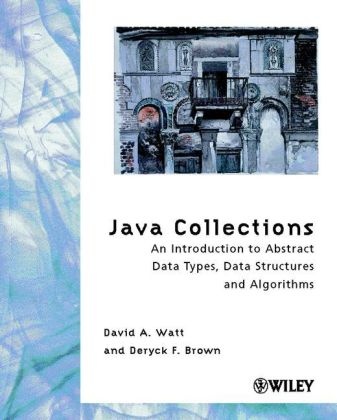Read more
Zusatztext "A lovely book.... I will use this book a lot in the next few months on a Java project I'm just starting." (CVu! December 2001) Informationen zum Autor David Watt is a Professor of Computing Science at the University of Glasgow. Deryck Brown is a Senior Lecturer in Computing Science at the Robert Gordon University, Aberdeen. Klappentext Java Collections is an introductory text on abstract data types, data structures, and algorithms using Java. Written at an appropriate level for a first course in algorithms and data structures, or a second course in programming using Java, this text concentrates on pratical matters like software design and the Jave Collections framework. Only essential supporting theory is included. The text focuses on abstract data types (ADTs) that turn up again and again in software design. It uses these ADTs to introduce and motivate the data structures required to implement them and the algorithms associated with the data structures. This approach helps Java programmers to choose the most suitable collection classes for their applications. Not only undergraduate students but also professional programmers retraining the program in Java will benefit form this even-paced and example-led text. Key features of the text: * emphasizes good object-oriented software design and implementation * presents algorithms both in English and in Java, and shows how to analyze their efficiency (with only light mathematics) * introduces the concept of an abstract data type, shows how to use a "contract" to specify the abstract data type's contract and its implementation in terms of a suitbale data structure and algorithms * covers a variety of abstract data types (stacks, queues, lists, sets, maps, priority queues, trees, and graphs), compares alternative implementations of these abstract types, and relates them to the Java collection classes * features numerous examples and case studies showing how the abstract data types are used in practical applciaitons * contains numerous graded exercises, offering opportunities to explore alternatives to the designs and implementations presented in the text * includes appendices summarizing the mathematics of algorithm analysis, the relevant features of the Java programming language, and the Java collection classes. Zusammenfassung Concentrates on the in-built collection classes in Java 2, enabling more emphasis on software design and less on theory. This book gives programmers the ability to choose the best collection classes for each application. The authors explore abstract data types (ADTs) that turn up again and again in software design. Inhaltsverzeichnis Introduction 1 Part I: Ready, Set, Go with VMware Infrastructure 3 9 Chapter 1: Exploring VMware Infrastructure 3 as Your Virtual Solution 11 Chapter 2: Getting the Scoop on Capacity Planning 23 Chapter 3: Knowing Your Storage Options 39 Part II: Setting Up ESX Hosts 55 Chapter 4: ESX: The Brawn Behind the Brains 57 Chapter 5: ESX Installation - Now the Fun Begins 67 Part III: Connecting the Physical to Your Virtual Environment 81 Chapter 6: Embracing the Look and Feel of VMware Infrastructure Client 83 Chapter 7: Virtual Networking 95 Chapter 8: Connecting to Storage 119 Part IV: Fault Tolerance and Data Centers 137 Chapter 9: Getting VMware Virtual Center Running 139 Chapter 10: Making Virtual Machines 161 Chapter 11: Managing Virtual Machines 175 Chapter 12: Keeping Things Running with Virtual Clusters 193 Part V: Playing Virtual Adminstrator 209 Chapter 13: Securing Your System 211 Chapter 14: Swimming in Resource Pools 229 Chapter 15: Monitoring Your System 243 Chapter 16: Preparing for Disaster 259 Chapter 17: Troubleshooting...
List of contents
Preface.
Introduction.
Algorithms.
The Array Data Structure.
Linked-List Data Structures.
Abstract Data Types.
Stack Abstract Data Types.
Queue Abstract Data Types.
List Abstract Data Types.
Set Abstract Data Types.
Binary Tree Data Structures.
Map Abstract Data Types.
Hash-Table Data Structures.
Priority-Queue Abstract Data Types.
Tree Abstract Data Types.
Graph Abstract Data Types.
Balanced Search Treet Data Structures.
Conclusion.
Appendix A: Summary of Mathematics for Algorithm Analysis.
Appendix B: Summary of Java.
Appendix C: Summary of the Java Collections Framework.
Further Reading.
Index.
Report
"A lovely book.... I will use this book a lot in the next few months on a Java project I m just starting." (CVu, December 2001)

